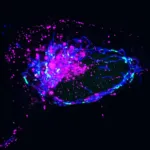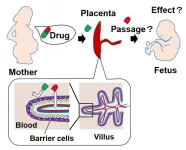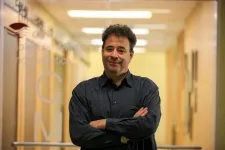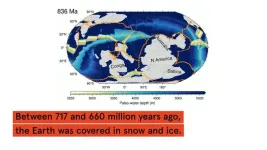(Press-News.org) LA JOLLA (February 8, 2024)—Cells in the human body contain power-generating mitochondria, each with their own mtDNA—a unique set of genetic instructions entirely separate from the cell’s nuclear DNA that mitochondria use to create life-giving energy. When mtDNA remains where it belongs (inside of mitochondria), it sustains both mitochondrial and cellular health—but when it goes where it doesn’t belong, it can initiate an immune response that promotes inflammation.
Now, Salk scientists and collaborators at UC San Diego have discovered a novel mechanism used to remove improperly functioning mtDNA from inside to outside the mitochondria. When this happens, the mtDNA gets flagged as foreign DNA and activates a cellular pathway normally used to promote inflammation to rid the cell of pathogens, like viruses.
The findings, published in Nature Cell Biology on February 8, 2024, offer many new targets for therapeutics to disrupt the inflammatory pathway and therefore mitigate inflammation during aging and diseases, like lupus or rheumatoid arthritis.
“We knew that mtDNA was escaping mitochondria, but how was still unclear,” says senior and co-corresponding author Professor Gerald Shadel, director of the San Diego-Nathan Shock Center of Excellence in the Basic Biology of Aging and holder of the Audrey Geisel Chair in Biomedical Science at Salk. “Using imaging and cell biology approaches, we’re able to trace the steps of the pathway for moving mtDNA out of the mitochondria, which we can now try to target with therapeutic interventions to hopefully prevent the resulting inflammation.”
One of the ways our cells respond to damage and infection is with what’s known as the innate immune system. While the innate immune response is the first line of defense against viruses, it can also respond to molecules the body makes that simply resemble pathogens—including misplaced mtDNA. This response can lead to chronic inflammation and contribute to human diseases and aging.
Scientists have been working to uncover how mtDNA leaves mitochondria and triggers the innate immune response, but the previously characterized pathways did not apply to the unique mtDNA stress conditions the Salk team was investigating. So, they turned to sophisticated imaging techniques to gather clues as to where and when things were going awry in those mitochondria.
"We had a huge breakthrough when we saw that mtDNA was inside of a mysterious membrane structure once it left mitochondria—after assembling all of the puzzle pieces, we realized that structure was an endosome,” says first author Laura Newman, former postdoctoral researcher in Shadel’s lab and current assistant professor at the University of Virginia. “That discovery eventually led us to the realization that the mtDNA was being disposed of and, in the process, some of it was leaking out.”
The team discovered a process beginning with a malfunction in mtDNA replication that caused mtDNA-containing protein masses called nucleoids to pile up inside of mitochondria. Noticing this malfunction, the cell then begins to remove the replication-halting nucleoids by transporting them to endosomes, a collection of organelles that sort and send cellular material for permanent removal. The endosome gets overloaded with these nucleoids, springs a leak, and mtDNA is suddenly loose in the cell. The cell flags that mtDNA as foreign DNA—the same way it flags a virus’s DNA—and initiates the DNA-sensing cGAS-STING pathway to cause inflammation.
“Using our cutting-edge imaging tools for probing mitochondria dynamics and mtDNA release, we have discovered an entirely novel release mechanism for mtDNA,” says co-corresponding author Uri Manor, former director of the Waitt Advanced Biophotonics Core at Salk and current assistant professor at UC San Diego. “There are so many follow-up questions we cannot wait to ask, like how other interactions between organelles control innate immune pathways, how different cell types release mtDNA, and how we can target this new pathway to reduce inflammation during disease and aging.”
The researchers hope to map out more of this complicated mtDNA-disposal and immune-activation pathway, including what biological circumstances—like mtDNA replication dysfunction and viral infection—are required to initiate the pathway and what downstream effects there may be on human health. They also see an opportunity for therapeutic innovation using this pathway, which represents a new cellular target to reduce inflammation.
Other authors include Sammy Weiser Novak, Gladys Rojas, Nimesha Tadepalle, Cara Schiavon, Christina Towers, Matthew Donnelly, Sagnika Ghosh, Sienna Rocha, and Ricardo Rodriguez-Enriquez of Salk; Danielle Grotjahn and Michaela Medina of The Scripps Research Institute; Marie-Ève Tremblay of the University of Victoria in Canada; Joshua Chevez of UC San Diego; and Ian Lemersal of the La Jolla Institute for Immunology.
The work was supported by the National Institutes of Health (R01 AR069876, P30AG068635, 1K99GM141482, 1F32GM137580, T32GM007198, 5R00CA245187, and 5R00CA245187-04S1), an Allen-AHA Initiative in Brain Health and Cognitive Impairment award (19PABH134610000H), a National Science Foundation NeuroNex Award (2014862), Chan-Zuckerberg Initiative Imaging Scientist Award, the LIFE Foundation, a George E. Hewitt Foundation for Medical Research Postdoctoral Fellowship, Paul F. Glenn Foundation for Medical Research Postdoctoral Fellowship, Salk Pioneer Fund Postdoctoral Scholar Award, the Waitt Foundation, Yale University School of Medicine Center for Cellular and Molecular Imaging, a Canada Research Chair (Tier 2) in Neurobiology of Aging and Cognition, and a Canada Foundation for Innovation John R. Evans Leaders Fund (grant 39965).
About the Salk Institute for Biological Studies:
Unlocking the secrets of life itself is the driving force behind the Salk Institute. Our team of world-class, award-winning scientists pushes the boundaries of knowledge in areas such as neuroscience, cancer research, aging, immunobiology, plant biology, computational biology, and more. Founded by Jonas Salk, developer of the first safe and effective polio vaccine, the Institute is an independent, nonprofit research organization and architectural landmark: small by choice, intimate by nature, and fearless in the face of any challenge. Learn more at www.salk.edu.
END
Faulty DNA disposal system causes inflammation
Salk scientists outline mouse cell inflammation pathway from mitochondrial stress to leaking endosomes to immune system initiation, revealing new potential therapeutic targets to reduce inflammation in aging and disease
2024-02-08
ELSE PRESS RELEASES FROM THIS DATE:
Breaking through barriers
2024-02-08
Researchers from Tokyo Medical and Dental University (TMDU) overcome scientific roadblocks and develop a model to assess the biology of the human placental barrier
Tokyo, Japan – During pregnancy, the human placenta plays multiple essential roles, including hormone production and nutrient/waste processing. It also serves as a barrier to protect the developing fetus from external toxic substances. However, the placental barrier can still be breached by certain drugs. In a recent article published in Nature Communications, a team led by researchers ...
Patterns of brain connectivity differ between pre-term and term babies
2024-02-08
Under strict embargo until 10.00 GMT Thursday 8 February 2024
A new King’s College London scanning study of 390 babies has shown distinct patterns between term and pre-term babies in the moment-to-moment activity and connectivity of brain networks.
Supported by Wellcome and the National institute of Health and Care Research (NIHR) Maudsley Biomedical Research Centre, this is the first study to analyse how the communication between brain areas changes moment-to-moment in the first few weeks of life.
Published in Nature Communications, the study also found that these dynamic ...
Social science: White actors featured more than non-white actors on American film posters
2024-02-08
White actors are featured more frequently and more prominently on posters for American-produced films than non-white actors despite recent increases in the representation of actors from other ethnic groups, according to a study published in Humanities and Social Sciences Communications.
Galit Fuhrmann Alpert and colleagues investigated trends in the ethnic diversity of actors featured on over 45,000 posters advertising over 24,000 English-speaking films produced in the USA between 1960 and 2021. Actors were assigned to one of four ethnic groups; white, Black, Indian, or Asian using an algorithm trained on the FairFace image dataset, which contains equal numbers ...
Researchers identify potential way to treat genetic epilepsy by replacing ‘lost’ enzyme
2024-02-08
Francis Crick Institute press release
Under strict embargo: 01:00hrs GMT Thursday 8 February 2024
Peer reviewed
Experimental study
Animals and cells
Researchers identify potential way to treat genetic epilepsy by replacing ‘lost’ enzyme
Scientists at the Francis Crick Institute have found a new treatment target for CDKL5 deficiency disorder (CDD), one of the most common types of genetic epilepsy.
CDD causes seizures and impaired development in children, and medications are limited to managing symptoms rather than tackling the root cause of the disease. The disorder involves losing the function of a gene producing the CDKL5 enzyme, which ...
New guidelines for reporting clinical trials of biofield therapies
2024-02-08
New guidelines for reporting clinical trials of biofield therapies are presented in the peer-reviewed Journal of Integrative and Complementary Medicine (JICM). Biofield therapies (BFTs), such as External Qigong, Healing Touch, Reiki, and Therapeutic Touch, are a related group of integrative medicine interventions in which practitioners use their hands on or above a client’s body to stimulate healing and well-being. Click here to read the article now.
The guidelines call for including details of the intervention protocols relevant to biofield therapy trials. The Reporting Evidence Guidelines comprises ...
Wayne State University awarded $1.4 million from Department of Defense to expand on research findings surrounding prostate cancer
2024-02-08
DETROIT– A team of researchers from Wayne State University was awarded a $1.4 million, three-year grant from the U.S. Department of Defense for the study, “Cytochrome c acetylation drives prostate cancer aggressiveness and Warburg effect.”
The study, led by Maik Hüttemann, Ph.D., professor of molecular medicine and genetics, and biochemistry, microbiology and immunology at Wayne State University’s School of Medicine, aims to establish the role of the protein cytochrome c, which the team proposes is ...
What turned Earth into a giant snowball 700m years ago? Scientists now have an answer
2024-02-08
Australian geologists have used plate tectonic modelling to determine what most likely caused an extreme ice-age climate in Earth’s history, more than 700 million years ago.
The study, published in Geology, helps our understanding of the functioning of the Earth's built-in thermostat that prevents the Earth from getting stuck in overheating mode. It also shows how sensitive global climate is to atmospheric carbon concentration.
“Imagine the Earth almost completely frozen over,” said the study’s lead author, ARC Future Fellow ...
Researchers estimate survival chances during CPR for cardiac arrest
2024-02-08
A person’s chance of surviving while receiving cardiopulmonary resuscitation (CPR) for cardiac arrest in hospital declines rapidly from 22% after one minute to less than 1% after 39 minutes, finds a US study published by The BMJ today.
Similarly, the likelihood of leaving hospital with no major brain damage declines from 15% after one minute of CPR to less than 1% after 32 minutes with no heartbeat.
The researchers say the findings provide insights that may help guide hospital teams, patients and their families in deciding how long to continue resuscitation.
In-hospital ...
Group rehabilitation improves quality of life for people with long covid
2024-02-08
An online programme of physical and mental health rehabilitation can improve quality of life for adults with long covid, finds a trial published by The BMJ today.
The eight week REGAIN programme, delivered in online group sessions, led to sustained improvements in fatigue, pain, and depression compared with usual care.
The researchers say this accessible, resource-efficient programme can be delivered at scale and will assist clinicians in the treatment of this complex condition.
Post-covid-19 condition (commonly known as long covid) ...
Anxiety of headteachers across England “substantially increased” during the pandemic
2024-02-08
The anxiety of headteachers across England increased “substantially” throughout the pandemic, finds the largest study of its type to-date.
The results of the research, which examined thousands of teachers’ anxiety about work at 75 touchpoints from October 2019 to July 2022, show that senior leaders in schools suffered – even “much more” when compared with junior colleagues.
The findings, published today in the peer-reviewed journal Educational Review, are the latest to demonstrate the mental ...
LAST 30 PRESS RELEASES:
Injectable breast ‘implant’ offers alternative to traditional surgeries
Neuroscientists devise formulas to measure multilingualism
New prostate cancer trial seeks to reduce toxicity without sacrificing efficacy
Geometry shapes life
A CRISPR screen reveals many previously unrecognized genes required for brain development and a new neurodevelopmental disorder
Hot flush treatment has anti-breast cancer activity, study finds
Securing AI systems against growing cybersecurity threats
Longest observation of an active solar region
Why nail-biting, procrastination and other self-sabotaging behaviors are rooted in survival instincts
Regional variations in mechanical properties of porcine leptomeninges
Artificial empathy in therapy and healthcare: advancements in interpersonal interaction technologies
Why some brains switch gears more efficiently than others
UVA’s Jundong Li wins ICDM’S 2025 Tao Li Award for data mining, machine learning
UVA’s low-power, high-performance computer power player Mircea Stan earns National Academy of Inventors fellowship
Not playing by the rules: USU researcher explores filamentous algae dynamics in rivers
Do our body clocks influence our risk of dementia?
Anthropologists offer new evidence of bipedalism in long-debated fossil discovery
Safer receipt paper from wood
Dosage-sensitive genes suggest no whole-genome duplications in ancestral angiosperm
First ancient human herpesvirus genomes document their deep history with humans
Why Some Bacteria Survive Antibiotics and How to Stop Them - New study reveals that bacteria can survive antibiotic treatment through two fundamentally different “shutdown modes”
UCLA study links scar healing to dangerous placenta condition
CHANGE-seq-BE finds off-target changes in the genome from base editors
The Journal of Nuclear Medicine Ahead-of-Print Tip Sheet: January 2, 2026
Delayed or absent first dose of measles, mumps, and rubella vaccination
Trends in US preterm birth rates by household income and race and ethnicity
Study identifies potential biomarker linked to progression and brain inflammation in multiple sclerosis
Many mothers in Norway do not show up for postnatal check-ups
Researchers want to find out why quick clay is so unstable
Superradiant spins show teamwork at the quantum scale
[Press-News.org] Faulty DNA disposal system causes inflammationSalk scientists outline mouse cell inflammation pathway from mitochondrial stress to leaking endosomes to immune system initiation, revealing new potential therapeutic targets to reduce inflammation in aging and disease






